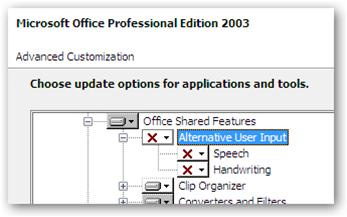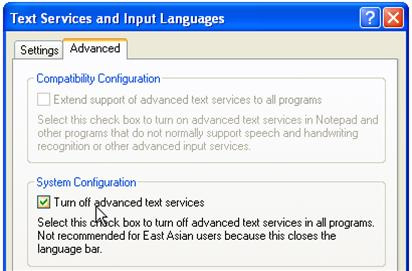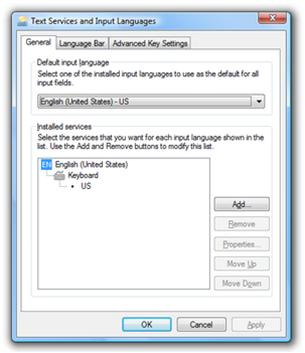What is the ctfmon.exe, svchost.exe file?
svchost.exe is the name of a process for services that operate from dynamic link libraries.Earlier, Microsoft moved all the functionality from a Windows-based service into .dll files instead of .exe files. However, we cannot directly activate dynamic library files (dll) to execute them, so the svchost.exe process is born.
There are a lot of svchost.exe processes running at the same time in the Processes or Services section (in Windows Vista) from the Task Manager because many Windows services are loaded when the operating system starts. If all services are included in the same svchost.exe process, when a minor problem occurs, all services will be stalled, resulting in the operating system to stop working. This is the main reason for separating services into different parts and operating under a svchost.exe process.
To turn off services running in the operating system, go to Start - Run , type services.msc, and then turn to the services that need to be locked. However, make sure they are not the key services or service groups. The best way is to use SysInternal's free Process Explorer utility under Microsoft to clearly identify the service or process through the information provided by this utility.
Similar to svchost.exe, ctfmon.exe is the process of controlling the language bar in Microsoft Office (Office Language bar) and AUI (Alternative User Input), temporarily called the user's alternative input method such as voice recognition , handwriting recognition, East Asia keyboard keys . if you use the above methods, you should let ctfmon.exe run permanently in the system.
The following is how the ctfmon.exe key is removed and completely removed from the operating system :
Remove "Alternative User Input" in Office 2003 and Windows XP, go to Control Panel , Add / Remove Programs , click on Microsoft Office 2003 - Add or Remove Features and check the box " Choose advanced customization of applications " before Click " Next " to continue.
Go to the " Office Shared Features - Alternative User Input " section and select " Not Available " to stop using.
 What is the ctfmon.exe, svchost.exe file? Picture 1
What is the ctfmon.exe, svchost.exe file? Picture 1
Stop using Alternative User Input
The next step is to lock the word in Windows XP by going to " Control Panel - Regional and Language Options ", go to the Languages tab and click " Details " in the first section. Next, select the " Advanced " tab, select " Turn off advanced text services ", it will turn off ctfmon quickly.
 What is the ctfmon.exe, svchost.exe file? Picture 2
What is the ctfmon.exe, svchost.exe file? Picture 2
Check "Turn off advanced text services"
In Windows Vista, it is easier to lock ctfmon. You also go to Control Panel - Regional and Language Options and select " Change keyboards or other input methods ". On the " Keyboards and Languages " tab select " Change keyboards ", the interface is similar to Windows XP, just remove the extended services installed in the list other than the default language keyboard list.
 What is the ctfmon.exe, svchost.exe file? Picture 3
What is the ctfmon.exe, svchost.exe file? Picture 3
Remove unnecessary extension services
The next step is to remove ctfmon from the boot list by going to Start - Run , typing msconfig , selecting the Startup tab in the " System Configuration Utility " dialog box, unchecking ctfmon. If unsuccessful, we again remove the registration part of the dynamic library (* .dll) that runs the alternate import services by executing two command lines, go to Start - Run , type cmd . Next, you in turn type the two command lines below:
Regsvr32.exe / u msimtf.dll
Regsvr32.exe / u msctf.dll
Restart the system to finish locking and removing ctfmon. However, neither ctfmon.exe and svchost.exe are the cause of the system slowdown as you mentioned. Maybe after a period of use, Windows becomes sluggish due to the many programs installed, followed by a series of their own services, or you should perform defragmentation (defrag) about every three months. . Most importantly, always update and open the anti-virus program in real time to prevent viruses and trojans from tampering with Windows services and run resident when the operating system starts.
See more:
- What is WMI Provider Host (WmiPrvSE.exe) and why is it using too much CPU?
- Device Association Framework Provider What is a Host and why is it running on a computer?
You should read it
- What is CTFMON.EXE and how to delete it
- What is Svchost.exe? How to check if svchost.exe contains a virus?
- What is svchost.exe?
- Svchost Viewer: look exactly at svchost.exe processes
- About svchost.exe
- How to fix Svchost.exe error permanently using multiple CPUs
- How to handle svchost.exe taking up RAM and CPU
- The truth about the automated process of running CTFMON.EXE
- What are filesystems? Basic knowledge of Filesystem
- How to post articles on Digitalized Knowledge System - itrithuc.vn
- Guide to Unix
- Which file system should be used for removable storage devices






 What is ISO file?
What is ISO file? How to open and read the .DAT file?
How to open and read the .DAT file? What is file 000?
What is file 000? What is DMG file?
What is DMG file? What is an XML file and how to open it?
What is an XML file and how to open it? What is a DLL file, and how does this file work?
What is a DLL file, and how does this file work?